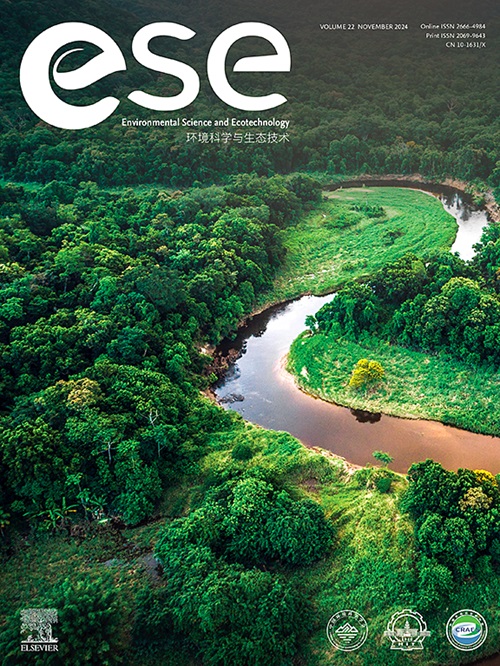Towards sustainable agroecosystems: A life cycle assessment review of soil-biodegradable and traditional plastic mulch films
IF 14.3
1区 环境科学与生态学
Q1 ENVIRONMENTAL SCIENCES
引用次数: 0
Abstract
The increasing use of traditional agricultural plastic mulch films (PMs) has raised significant environmental concerns, prompting the search for sustainable alternatives. Soil-biodegradable mulch films (BDMs) are often proposed as eco-friendly replacements; however, their widespread adoption remains contentious. This review employs a comparative life cycle assessment perspective to evaluate the environmental impact of PMs and BDMs across their production, use, and end-of-life stages, providing strategies to mitigate their impact on agroecosystems. BDMs generally exhibit lower energy use and greenhouse gas emissions than PMs but contribute to greater land-use demands. Reported eutrophication and acidification potentials are less consistent, varying based on feedstock types and the scope of assessment of BDM, as well as the end-of-life management of PM. The environmental burden of both mulch types is influenced by the life cycle stage, polymer composition, farming practices, additives, film thickness, and local climatic conditions. The manufacturing stage is a major contributor to energy use and greenhouse gas emissions for both PMs and BDMs, despite their shared benefits of increasing crop yields. However, post-use impacts are more pronounced for PMs, driven by end-of-life strategy and adsorbed waste content. While starch-based BDMs offer a more sustainable alternative to PMs, uncertainties regarding the residence time of BDM residues in soil (albeit shorter than PM residues) and their effects on soil health, coupled with higher production costs, impede widespread adoption. For BDM end-of-life, soil biodegradation is recommended. Energy and material recovery options are crucial for PM end-of-life, with mechanical recycling preferred, although it requires addressing eutrophication and human toxicity. This review discusses these complexities within specific contexts and provides actionable insights to guide the sustainable integration of mulch films into agricultural practices.

迈向可持续农业生态系统:土壤可生物降解地膜和传统地膜的生命周期评价综述
越来越多地使用传统农用塑料地膜(pm)引起了严重的环境问题,促使人们寻找可持续的替代品。土壤可生物降解地膜(bdm)经常被提议作为生态友好的替代品;然而,它们的广泛采用仍然存在争议。本综述采用比较生命周期评估的观点来评估pmms和bdm在其生产、使用和生命终止阶段的环境影响,并提出减轻其对农业生态系统影响的策略。与pm相比,bdm的能源使用和温室气体排放通常较低,但造成了更大的土地使用需求。报告的富营养化和酸化潜力不太一致,根据原料类型和BDM评估范围以及PM的寿命结束管理而有所不同。两种覆膜类型的环境负担受生命周期阶段、聚合物组成、耕作方式、添加剂、薄膜厚度和当地气候条件的影响。制造阶段是pm和bdm的能源消耗和温室气体排放的主要贡献者,尽管它们可以共同提高作物产量。然而,pm的使用后影响更为明显,这是由寿命终止策略和吸附废物含量驱动的。虽然淀粉基BDM提供了比PM更可持续的替代品,但BDM残留物在土壤中的停留时间(尽管比PM残留物短)及其对土壤健康的影响的不确定性,加上较高的生产成本,阻碍了BDM的广泛采用。对于BDM的报废,建议采用土壤生物降解。能源和材料回收方案对于PM的报废至关重要,机械回收是首选,尽管它需要解决富营养化和人体毒性问题。本综述在具体背景下讨论了这些复杂性,并提供了可操作的见解,以指导地膜与农业实践的可持续整合。
本文章由计算机程序翻译,如有差异,请以英文原文为准。
求助全文
约1分钟内获得全文
求助全文
来源期刊

Environmental Science and Ecotechnology
Multiple-
CiteScore
20.40
自引率
6.30%
发文量
11
审稿时长
18 days
期刊介绍:
Environmental Science & Ecotechnology (ESE) is an international, open-access journal publishing original research in environmental science, engineering, ecotechnology, and related fields. Authors publishing in ESE can immediately, permanently, and freely share their work. They have license options and retain copyright. Published by Elsevier, ESE is co-organized by the Chinese Society for Environmental Sciences, Harbin Institute of Technology, and the Chinese Research Academy of Environmental Sciences, under the supervision of the China Association for Science and Technology.
 求助内容:
求助内容: 应助结果提醒方式:
应助结果提醒方式:


